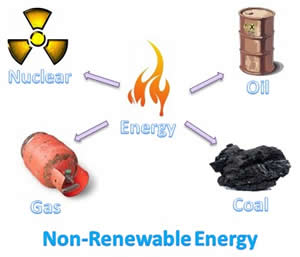Difference between Renewable and Nonrenewable Resources
Key Difference: A renewable resource is a natural resource which can be replenished through means of biological reproduction of other naturally occurring processes. On the other hand, a non-renewable resource is a natural resource which cannot be replenished as compared to its consumption.
 Natural resources are of great importance to man and other creatures. They are broadly categorized into two groups - renewable and non-renewable types. Renewable refers to those types of resources which will be available in the future as they can be either reused or replenished. On the other hand, non-renewable resources are those which will be all consumed or exhausted someday and therefore will not be available in the future. It is very difficult to replenish them.
Natural resources are of great importance to man and other creatures. They are broadly categorized into two groups - renewable and non-renewable types. Renewable refers to those types of resources which will be available in the future as they can be either reused or replenished. On the other hand, non-renewable resources are those which will be all consumed or exhausted someday and therefore will not be available in the future. It is very difficult to replenish them.
Renewable resources are those resources which one should not bother as much as about non-renewable resources. These are the ones which will never run out. For example -trees, they are renewable as they can always be grown even if cut down. Animals, air, water, etc. are all renewable resources. Air and water gets renewed in cycles. It consists of all those resources which can be replenished through nature or human activity.
 On the other hand, non-renewable resources include fossil fuels like oil, coal and gas, as they will eventually run out some day. These resources will be exhausted forever after being used once in unlimited ways. These are mostly the ones which come from the Earth itself. They are also put into two categories mainly– fossil fuels and nuclear fuels. Fossil fuels include oil, coal and gas. Fossil fuels take millions of years to form. Nuclear fuels are derived from mining and refining of Uranium ore. Nuclear fuels are considered to be better and they are the cleanest of all non-renewable resources.
On the other hand, non-renewable resources include fossil fuels like oil, coal and gas, as they will eventually run out some day. These resources will be exhausted forever after being used once in unlimited ways. These are mostly the ones which come from the Earth itself. They are also put into two categories mainly– fossil fuels and nuclear fuels. Fossil fuels include oil, coal and gas. Fossil fuels take millions of years to form. Nuclear fuels are derived from mining and refining of Uranium ore. Nuclear fuels are considered to be better and they are the cleanest of all non-renewable resources.
Renewable resources can be renewed. However, if the consumption rate becomes greater than the renewal rate, the renewal and sustainability gets affected. A non-renewable resource has a fixed amount and gets consumed faster than being replenished or made by nature. Therefore, renewable and non-renewable resources are different types of resources.
A strong emphasis is being made for reusability and recycling of resources to ensure the availability of the resources. Renewable resources are generally clean and cheap to operate. They do not damage the environment. Non-renewable resources are generally very cheap and easy to use. They are known for their efficiency. They are able to produce a lot of energy in a short interval of time.
Disadvantages of renewable resources are that it is very costly to build them. They are not as efficient as non-renewable resources in context to production of energy. They can also be sometimes noisy. On the other hand, the biggest disadvantage of a non- renewable resource is that it will eventually run out. It is not clean. They bring a lot of dangers to the environment. It is important to mention that 95 percent of the world‘s energy is constituted by the non-renewable resources.
Comparison between Renewable and Non-renewable Resources:
|
Renewable Resources |
Nonrenewable Resources |
|
|
Definition |
A resource which can be replenished or reused. It means it will never run out |
This type of resource cannot be replenished |
|
Example |
Water, crops, wind, solar, geothermal |
Coal, Petroleum, natural gas, etc. |
|
Advantages |
|
|
|
Disadvantages |
|
|
Image Courtesy: examplesofrenewableresources.com, swiftutors.com









Add new comment